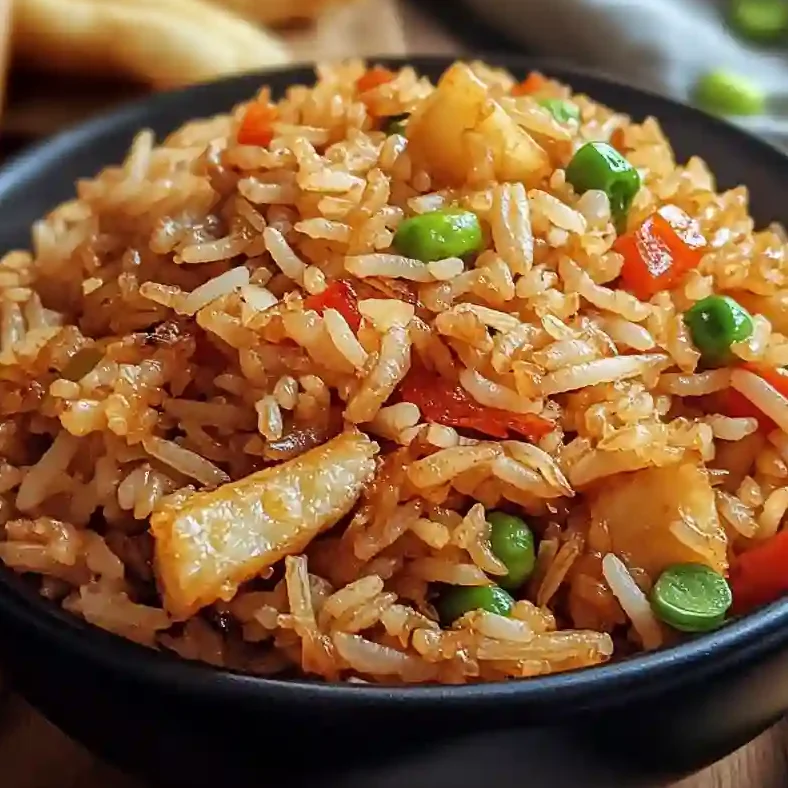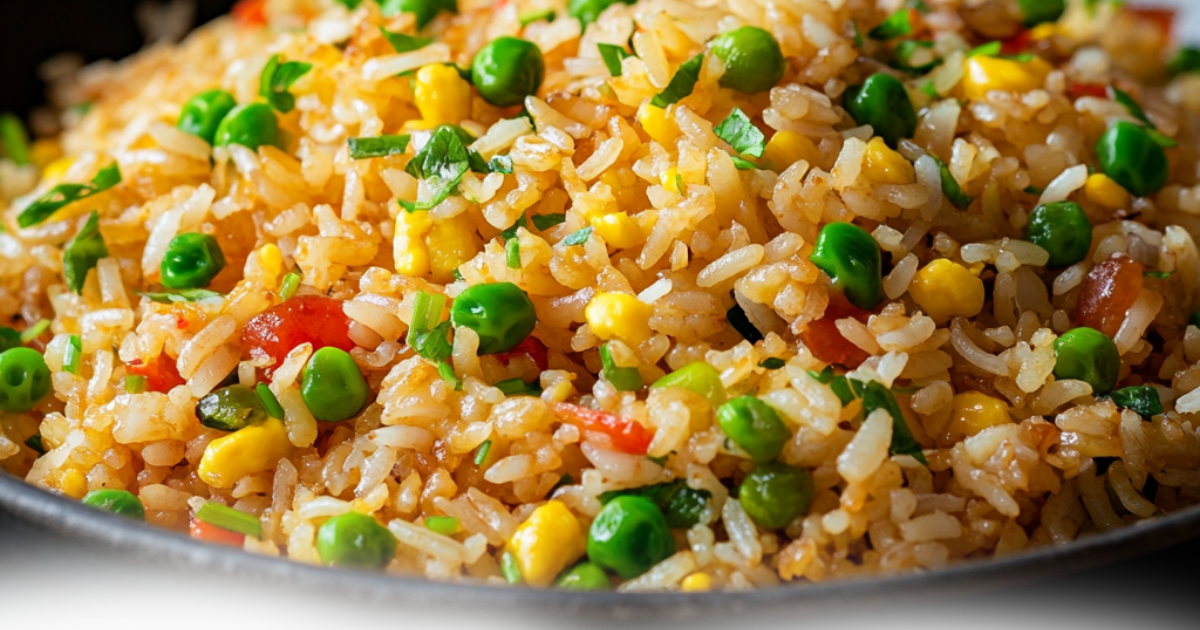Chinese fried rice is beloved worldwide for its irresistible aroma, vibrant texture, and complex taste. But what gives Chinese fried rice its flavour? The answer lies in a harmonious combination of essential techniques, ingredients, and traditions. In this article, we’ll dissect the components that make this dish a staple in Chinese cuisine and a favorite across cultures.
Table of contents
Why Leftover Rice Is the Secret Ingredient
One fundamental element in understanding what gives Chinese fried rice its flavour is the use of leftover rice. Freshly cooked rice tends to be too moist and sticky, which can result in a clumpy and mushy dish. Leftover rice, however, is drier and firmer, making it ideal for frying.

Using day-old rice offers several advantages:
- Texture Improvement: Dry grains prevent clumping and allow for even frying.
- Flavor Absorption: Less moisture means the rice can absorb sauces and seasonings more effectively.
- Enhanced Crispiness: Drier rice achieves that slight crisp on the edges, adding to the overall texture.

Before cooking, break up any lumps in the leftover rice to ensure each grain is separate. This simple step is crucial in achieving the authentic taste and texture that define Chinese fried rice.
Essential Ingredients That Define the Flavor
To uncover what makes Chinese fried rice so flavorful, we must examine its essential ingredients. Each component adds a unique layer to the dish’s complex taste profile.
Key ingredients include:
- Rice: Preferably jasmine or long-grain, serving as the dish’s foundation.
- Soy Sauce: Provides umami and a savory depth.
- Sesame Oil: Adds a subtle nuttiness and aromatic quality.
- Aromatics: Garlic, ginger, and scallions infuse the dish with fragrant flavors.
- Proteins and Vegetables: Eggs, shrimp, chicken, peas, and carrots contribute texture and additional taste layers.

Discover the interplay of these ingredients in our feature on the best sauces and seasonings for Chinese dishes.
The Impact of Aromatics: Garlic, Ginger, and Scallions
Aromatics play a significant role in what gives Chinese fried rice its flavour. Garlic, ginger, and scallions are the trifecta that forms the aromatic base of the dish.
- Garlic: Imparts a robust, savory note that enhances other flavors.
- Ginger: Introduces a warm, slightly spicy undertone.
- Scallions: Offer a fresh, mild onion flavor and add a splash of color.
Sautéing these aromatics in hot oil at the beginning releases their essential oils, which then permeate the rice. This process ensures that every bite is infused with their distinct flavors.
Selecting the Right Rice for Authentic Taste
Choosing the appropriate type of rice is crucial in discovering what gives Chinese fried rice its flavour. The texture and flavor of the rice itself can significantly impact the final dish.
Recommended rice varieties:
- Jasmine Rice: Known for its fragrant aroma and slightly sticky texture.
- Long-Grain Rice: Keeps grains separate, ideal for fried rice.
- Medium-Grain Rice: Offers a balance between stickiness and fluffiness.

Avoid short-grain rice, as it is too sticky and can result in a mushy texture. Always ensure the rice is cooled and preferably refrigerated before using it in your recipe.
The Role of Sauces and Oils in Flavor Enhancement
Sauces and oils are integral to what gives Chinese fried rice its distinctive taste. They add depth, richness, and complexity to the dish.
Essential sauces and oils:
- Soy Sauce: The primary source of umami and saltiness.
- Sesame Oil: Provides a toasty, nutty aroma.
- Oyster Sauce: Adds sweetness and depth.
- Fish Sauce (Optional): Introduces an additional layer of umami.
- White Pepper: Gives a subtle heat unique to Chinese cuisine.
Use these condiments judiciously to balance flavors. Overuse can lead to an overpowering taste, masking other ingredients.
Mastering the Wok Hei Technique
One of the elusive secrets to what gives Chinese fried rice its flavour is achieving the wok hei, or “breath of the wok.” This refers to the smoky, seared flavor that comes from cooking over extremely high heat.
To achieve wok hei at home:
- Use High Heat: Preheat your wok or pan until it is smoking hot.
- Choose the Right Equipment: A carbon steel wok is ideal for heat retention.
- Stir-Fry Quickly: Cook ingredients rapidly to prevent burning while achieving a slight char.
- Avoid Overcrowding: Cook in batches if necessary to maintain high heat.
Mastering wok hei requires practice but significantly enhances the dish’s authentic flavor.
Balancing Flavors for the Perfect Dish
Understanding what contributes to the flavor of Chinese fried rice involves balancing all elements harmoniously. The interplay between rice, aromatics, proteins, sauces, and cooking techniques creates the dish’s signature taste.
Tips for flavor balance:
- Taste as You Go: Adjust seasonings incrementally.
- Avoid Overloading Ingredients: Too many add-ins can overwhelm the rice.
- Consider Texture: Include ingredients that offer varying textures for a more interesting dish.
By paying attention to these details, you can recreate the authentic flavor that makes Chinese fried rice a favorite worldwide.
Step-by-Step Guide: How to Bring Out Authentic Chinese Fried Rice Flavour
Creating restaurant-quality fried rice at home requires attention to detail and the right combination of ingredients. Each component contributes to its distinct taste.
Key Ingredients for Flavorful Fried Rice:
- Day-old rice: Dry, slightly firm grains absorb flavors better.
- Soy sauce: Adds a salty, umami-rich depth.
- Oyster sauce: Provides subtle sweetness and complexity.
- Sesame oil: Enhances the nutty aroma.
- Garlic and ginger: Foundational aromatics for boldness.
- Vegetables and proteins: Customize with peas, carrots, shrimp, or chicken.
Step-by-Step Instructions:
- Prepare the rice: Use cold, day-old rice to prevent clumping.
- Heat the wok: Ensure it’s extremely hot for optimal stir-frying.
- Sauté aromatics: Cook garlic, ginger, and green onions until fragrant.
- Add protein and veggies: Cook them separately to ensure even cooking.
- Season and toss: Combine soy sauce, oyster sauce, and a dash of white pepper.
- Finish with sesame oil: Stir in at the end for an authentic taste.
By focusing on these steps, you’ll discover how to replicate the bold, balanced flavors of your favorite fried rice.
Regional Inspirations: The Differences Between Yangzhou, Sichuan, and Cantonese Fried Rice
China’s diverse culinary heritage means that fried rice takes on various regional interpretations. Each variation highlights unique flavors and ingredients, demonstrating what gives Chinese fried rice its flavour in different ways.
Yangzhou Fried Rice: A Subtle Take on Chinese Fried Rice Flavour
- Renowned for its light seasoning and focus on the natural taste of ingredients.
- Signature elements include diced ham, shrimp, egg, and mixed vegetables.
- Minimal soy sauce ensures the dish remains visually vibrant.
Sichuan Fried Rice: Spicy and Bold Chinese Fried Rice Flavour
- Packed with bold flavors, thanks to Sichuan peppercorns and chili oil.
- Commonly includes pickled vegetables or spicy sausage for heat and tang.
- Perfect for those who enjoy spicier versions of fried rice.
Cantonese Fried Rice: Light, Sweet, and Delicate Flavour Notes
- Known for its delicate flavors, often enhanced with fresh seafood or barbecue pork.
- Incorporates light soy sauce and subtle aromatics.
- Balanced with a hint of sweetness for an all-rounded taste.
By exploring these regional differences, you can appreciate what gives Chinese fried rice its flavour and how it evolves across China.
Creative Recipes: How to Add a Twist to the Classic Chinese Fried Rice Flavour
Chinese fried rice has inspired countless creative adaptations in American kitchens. While traditional flavors remain, many recipes incorporate local ingredients to explore what gives Chinese fried rice its flavour in a new context.
Popular American-Style Variations:
- Hawaiian Fried Rice: Combines pineapple chunks and ham for a sweet-savory fusion.
- Breakfast Fried Rice: Includes crispy bacon, scrambled eggs, and scallions.
- Tex-Mex Fried Rice: Features black beans, corn, and spicy chipotle seasoning.
- Vegetarian Fried Rice: Showcases kale, zucchini, and tofu for a nutritious twist.
Each version highlights how innovative ingredient combinations can enhance what gives Chinese fried rice its flavour, making it accessible for every palate.
Avoid Common Pitfalls: Tips to Perfect the Flavour of Chinese Fried Rice
Cooking fried rice may seem straightforward, but small mistakes can impact its final taste. Identifying these pitfalls ensures you achieve the authentic taste of what gives Chinese fried rice its flavour.
Frequent Mistakes:
- Using freshly cooked rice: Leads to mushy and sticky fried rice.
Fix: Always use day-old, refrigerated rice for the best texture. - Overloading the wok: Results in uneven cooking.
Fix: Cook in small batches for consistent results. - Skipping aromatics: Neglecting garlic and ginger diminishes the flavor profile.
Fix: Always sauté aromatics before adding other ingredients. - Excessive soy sauce: Overpowers the dish.
Fix: Use sauces sparingly to balance the flavors.
Avoiding these errors will ensure every bite captures what gives Chinese fried rice its flavour.
Balancing Health and Taste: Preserving the Essence of Chinese Fried Rice Flavour
While fried rice is delicious, many wonder whether it can be a healthy choice. The answer lies in balancing the elements that define what gives Chinese fried rice its flavour with mindful ingredient choices.
Healthier Fried Rice Tips:
- Replace white rice with brown rice or cauliflower rice for added fiber.
- Limit oil: Use a non-stick pan to reduce the need for excess oil.
- Incorporate more vegetables: Add colorful bell peppers, broccoli, and snap peas.
- Use lean proteins: Opt for chicken breast, shrimp, or tofu.
- Control sodium: Replace soy sauce with low-sodium alternatives or coconut aminos.
By making small adjustments, you can maintain what gives Chinese fried rice its flavour while supporting a healthier lifestyle.
Fried Rice Masterclass: FAQs on Achieving the Perfect Chinese Fried Rice Flavour
- What type of rice works best?
Long-grain rice like jasmine or basmati holds up well during stir-frying. - How do I prevent clumping?
Use chilled, separated grains and a hot wok. - Can I make it vegetarian?
Yes! Swap proteins for plant-based options and increase vegetable quantities. - What spices are essential?
White pepper, five-spice powder, and chili flakes add depth. - Can I freeze fried rice?
Absolutely! Store in airtight containers and reheat over medium heat for freshness.
By addressing these questions, you’ll gain confidence in replicating what gives Chinese fried rice its flavour at home.
Why It’s a Family Favorite: The Appeal of Chinese Fried Rice Flavour in American Homes
Fried rice has become a staple in American kitchens due to its versatility and ease of preparation. But what gives Chinese fried rice its flavour also makes it suitable for countless occasions, from weeknight dinners to festive gatherings.
Why It’s Loved:
- Customizable: Perfect for using up leftover ingredients.
- Quick to prepare: Ready in under 30 minutes.
- Crowd-pleasing: Satisfies diverse tastes with minimal effort.
A Simple Recipe for Every Occasion:
- Heat oil in a wok over high heat.
- Sauté garlic and ginger, followed by vegetables and proteins of choice.
- Add rice, seasonings, and sauces. Stir until well-coated.
- Finish with sesame oil and garnish with green onions.
This simple method exemplifies what gives Chinese fried rice its flavour while adapting seamlessly to different settings.
Mastering fried rice is about understanding its essence. By focusing on the elements that define what gives Chinese fried rice its flavour, you can elevate this humble dish into something extraordinary.

